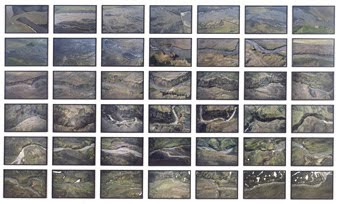To enter 'The Edge of Elsewhere' you need to walk through Khaled Sabsabi's hypnotic video installation '99', it sets the bar very high for what will be (unless we're incredibly lucky) one of the best shows in Sydney this year. Three weeks in that's a big claim but the immediacy, depth and moral fibre of some of the work here at the Campbelltown Arts Centre make it an extraordinarily powerful achievement.

'99' is an installation of 99 televisions, on racks four high, on either side of the 'L'-shaped entrance to the exhibition. Each television has a dual image, in the background is news footage of Middle East (what could be Palestine or Iraq), familiar and depressing, rubble, explosions, distress. Over this are various grainy repeated images of a whirling dervish. The super-8 graininess makes them look like photographs from the nineteenth century, the dervish's white garments filling the screen, each clip short and repeated. The soundtrack seems to come from each screen, a crashing chat that has strobed into a rhythm. It's an incredible effect. The dervish seeks enlightenment and rapture from his repetition, the footage gives us only darkness and confusion. The ghostly pairing of antique and modern asks questions of Western views of Islam too, about the supposed inevitability of a clash of cultures. This is much more than a tricky juxtaposition. '99' is powerful because it has so much of the characteristics of great religious art, it searches for peace through the ecstatic and is thus highly affecting.


The sheer physical centrepiece of the show is Wang Jianwei's multimedia, multi room, multi-ideaed installation 'Hostage'. It's hard to describe and seems more like the culmination of a project to demonstrate the deadening effects of ideology rather than a single artwork. The first elements you encounter are massive sculptures, Heath Robinson machines made of pipes and cogs and taps. From them emanate vast gloopy solid clouds. It's like a machine to produce nothing, conformity, sameness and it manages to be both cute and sinister. The arrangement of the three sculptural pieces is important, at one end of the long machine pumping out its clouds of conformist thought is a red curtain, less theatrical than reminding us of the 'Wizard of Oz' it might be the barrier between the rhetoric and the intent of a communist regime. On its other side a boiler or perhaps even a space ship compartment sits, encased in that familiar white, this time with two drivers, reproducing themselves in a shapeless mass. The works support more than a single interpretation (although I was struck so powerfully by my own at the time) but the accompanying film and stills do lead us down a particular path.
The video piece places us firmly in Communist China, possibly in the cultural revolution. It's a wordless highly theatrical (in that it takes place on a soundstage in three walls) tableau of brutalisation and the rituals of totalitarianism. The film is beautifully almost mournfully lit and has a tone of regret and reverie. There are strong echoes of socialist realist art, as the dispassionate, almost banal, nature of the crimes committed on the main group (initiated by figures who remind us of Mao the shepherd, the peasantry and the Red Guard) unfold. Sitting alongside the fanciful machine installations the film makes a powerful work, there is always a human aspect to ideological imperatives, a lesson we should never forget.


There are other jewels here, Lisa Reihana's 'Digital Marae', attempting to project a version of Maori identity into the future or Indonesian artist Arahmaini meditation on the compartmentalisation of aspects of Indonesian femininity. For all this quality I don't know what the title 'Edge of Elsewhere' is supposed to mean. It's one of those non-sequitirs that art folk love. Like the accompanying catalogue, almost parodically filled with academic unspeak, it fails to convey the real power of the work here. It doesn't matter. So many of these pieces need no explanation but promise to infiltrate our selves and ask us again and again how we should live our lives, how we should make our worlds. This is socially and politically engaged art at its most human.



























